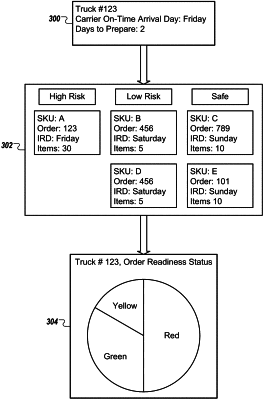| CPC G06Q 10/0875 (2013.01) [G06Q 10/06313 (2013.01); G06Q 10/06314 (2013.01); G06Q 10/0833 (2013.01)] | 20 Claims |

|
1. A system for providing interfaces for visualizing and managing a supply chain, the system comprising:
an inventory readiness date system comprising at least a first processor and a first memory storing date system instructions that, when executed, cause the inventory readiness data system to generate inventory readiness dates and milestone dates for items in the supply chain, wherein the inventory readiness dates (i) are calendar dates on which the items are expected to be available for distribution at destination locations, (ii) are generated upon creation of orders for the items, and (iii) are configured to remain fixed and unchanged for the items regardless of events affecting delivery of the items to the destination locations, and wherein the milestone dates are calendar dates by which milestone events are identified to occur to stay on track to satisfy the inventory readiness date;
a supply chain data system comprising at least a second processor and a second memory storing data system instructions that, when executed, cause the supply chain data system to receive and aggregate supply chain information for the items from a plurality of supply chain data sources, wherein the supply chain information specifies, for each item, data values across multiple data dimensions, wherein the supply chain data system is configured to perform operations comprising:
receiving transit event data that indicates that a physical location of one or more of the items has changed;
in response to receiving the transit event data, determining a readiness status for each of the one or more items for which the transit event data pertains, by (i) determining one or more projected milestone dates for the item based on the received transit event data, and (ii) comparing the one or more projected milestone dates for the item to corresponding milestone dates for the item, wherein the readiness status corresponds to an enumerated category that indicates whether the item is on track to satisfy its inventory readiness date; and
for each of the one or more items for which the transit event data pertains, storing the readiness status that has been determined for the item; and
a supply chain tracking system comprising at least a third processor and a third memory storing tracking system instructions that, when executed, cause the supply chain tracking system to generate and present interfaces for visualizing and managing the supply chain, wherein the supply chain tracking system is configured to perform operations comprising:
receiving through a communication network a search request with search parameters from a client computing device remote from the supply chain tracking system, wherein the search parameters include one or more specified values for one or more specified data dimensions for the items;
identifying, from the supply chain data system, a portion of the items that satisfy the search parameters;
generating aggregated multi-factor metrics for the portion of the items that satisfy the search parameters, comprising: (i) for each item of the portion of the items, identifying, from the supply chain information of the supply chain data system, the readiness status of the item, and (ii) aggregating the items that have readiness statuses that belong to a same enumerated category, wherein the aggregated multi-factor metrics are a multi-part score that represents projections for meeting future inventory readiness dates for the items of the portion of the items according to their enumerated categories;
outputting the aggregated multi-factor metrics for presentation in an interface on the client computing device; and
generating and transmitting, based on the aggregated multi-factor metrics meeting a threshold value, computer-readable instructions to one or more automated load handling systems to expedite a particular load that includes a threshold number of items that are projected to miss their inventory readiness dates, wherein the one or more automated load handling systems are configured to, upon receipt of the computer-readable instructions, automatically perform one or more operations to expedite processing of the particular load.
|